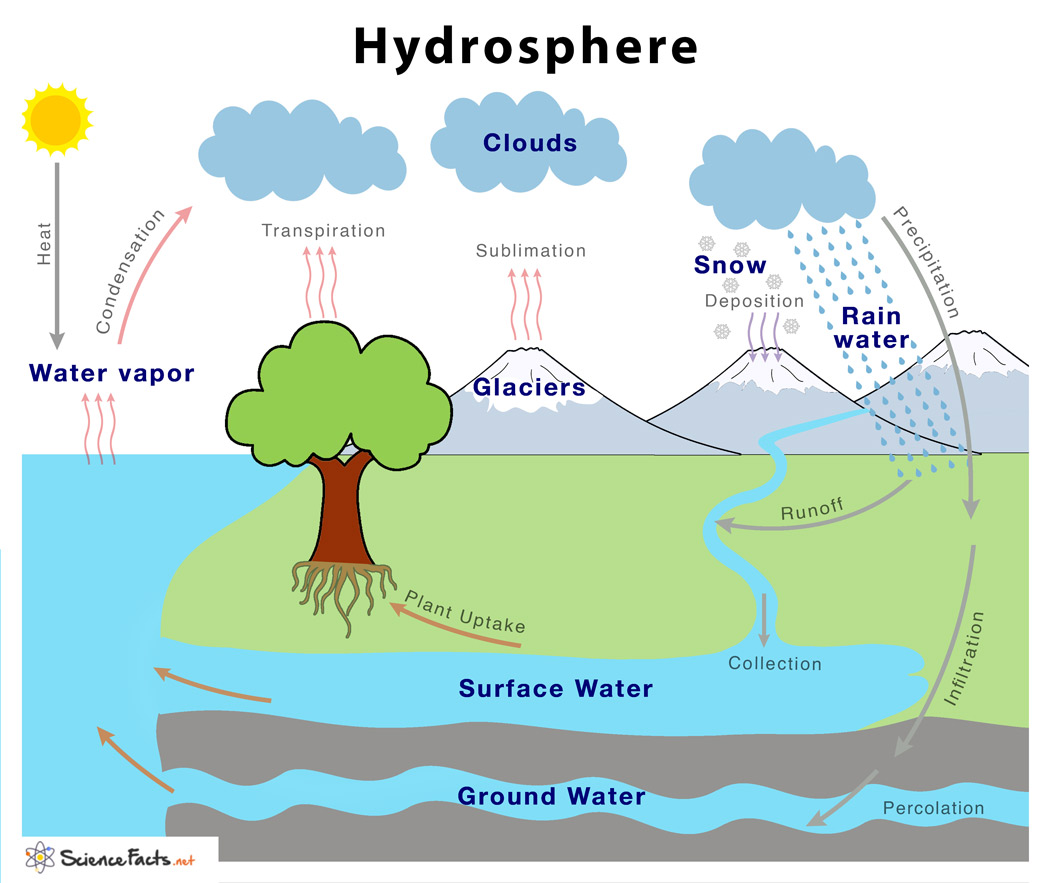Hydrosphere
The hydrosphere refers collectively to all forms of water on Earth. It includes surface water bodies like rivers, oceans, lakes, and ponds, groundwater, water vapor (clouds and fog) in the atmosphere, and ice.
Hydrosphere clearly distinguishes our planet from others, as almost two-thirds of the Earth is covered with water. However, not all water is available to us. The water below the water table cannot be made available for human use. Further, all available water is not fit for drinking purposes.
How is Water Distributed in the Hydrosphere
97.5% of Earth’s water is seawater and thus salty, leaving only 2.5% fresh water. Within 2.5%, nearly 70% is frozen, and only 30% is underground. The frozen part of the hydrosphere consists of glaciers, ice caps, and icebergs. This part of the hydrosphere is called the cryosphere.
What Makes Up the Hydrosphere
The different components of the hydrosphere vary in their state (solid, liquid, or gas) and the location where they are found. It is composed of the following:
1. Oceans: It is the largest reservoir of water on Earth. The water here is salty.
2. Fresh water: It is less abundant than salt water and is available as:
a) Surface water: The water present in lakes, rivers, and streams
b) Groundwater: The water present beneath the Earth’s surface in rock pores and the fractures of rock formations
3. Glacial water: The water that melts from glaciers
4. Water vapor: The water present in the atmosphere
In addition to water, the hydrosphere also contains dissolved minerals, dissolved gases, and particulates.
All forms of water on Earth are recycled and interchanged from one form to another through the water cycle.
Hydrosphere and the Water Cycle
The water in various forms moves through the hydrosphere in a cycle known as the hydrologic or water cycle. It is powered by the energy of the sun. The movement of water within the hydrosphere and the exchange of water with the cryosphere are the basis of the hydrologic cycle.
The different steps of the cycle are described below:
Evaporation: The heat of the sun causes surface water bodies to evaporate into the atmosphere. Plants also lose water from their aerial parts through transpiration. In this way, the hydrosphere interacts with the atmosphere.
Condensation: Water vapor in the air cools off, becomes dense, and forms droplets. This process is called condensation. When the droplets are tiny and light enough to stay suspended in the air, they form clouds.
Precipitation: When the water droplets in the air fall, it is called precipitation. Some common forms of precipitation are rain, snow, sleet, and hail.
Precipitation falling on the ground is absorbed and soaked into the ground by infiltration. Some water runoff into the nearby water bodies again takes part in evaporation in the next cycle. This process shows how the geosphere interacts with the hydrosphere.
The water cycle makes water available to all living organisms and thus helps them to continue living in the biosphere. The climate on Earth depends on the hydrosphere and the formation of clouds for precipitation.
Why is the Hydrosphere Important
Water sustains almost all life forms on Earth. Some important roles of the hydrosphere are:
- Component of Cell: Each living cell contains almost 75% of water. All chemical reactions in a cell require water. Thus no cell will function in its absence.
- Human Needs: Human needs water for drinking. Besides, many human activities, such as cleaning and washing, require water. Also, water is used for generating electricity.
- Habitat for Aquatic Organisms: The hydrosphere provides a place for many plants and animals to live. They require dissolved gases and minerals in water for their growth and development.
- Regulate Climate: Water helps to regulate the temperature on Earth with the help of the water cycle.
Apart from the above functions, the hydrosphere plays many other roles in maintaining the stability of Earth.
Human Impacts on the Hydrosphere
Human activities like water pollution, river damming, wetland drainage, climate change, irrigation, and deforestation have changed the hydrosphere drastically over the years. Releasing fertilizers, pesticides, and sewage into the water bodies causes eutrophication or algal bloom. It also causes an anaerobic environment leading to the death of aquatic animals. When the oxides of nitrogen and sulfur in the atmosphere precipitate down as rain, it increases the acidic content of the water bodies. Finally, human activities like creating dams and diverting water bodies harm the nearby ecosystems that depend on those water sources.
-
References
Article was last reviewed on Tuesday, February 21, 2023




